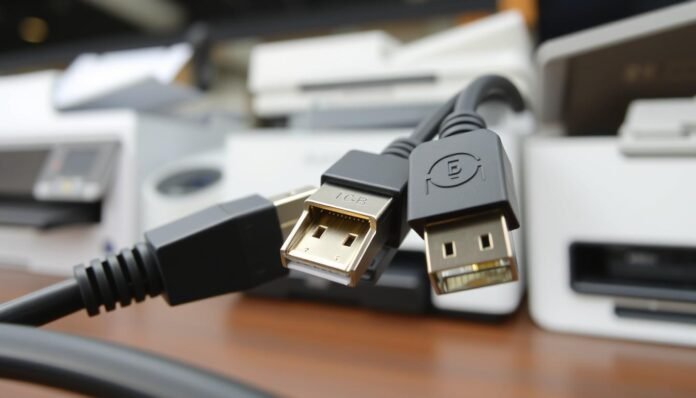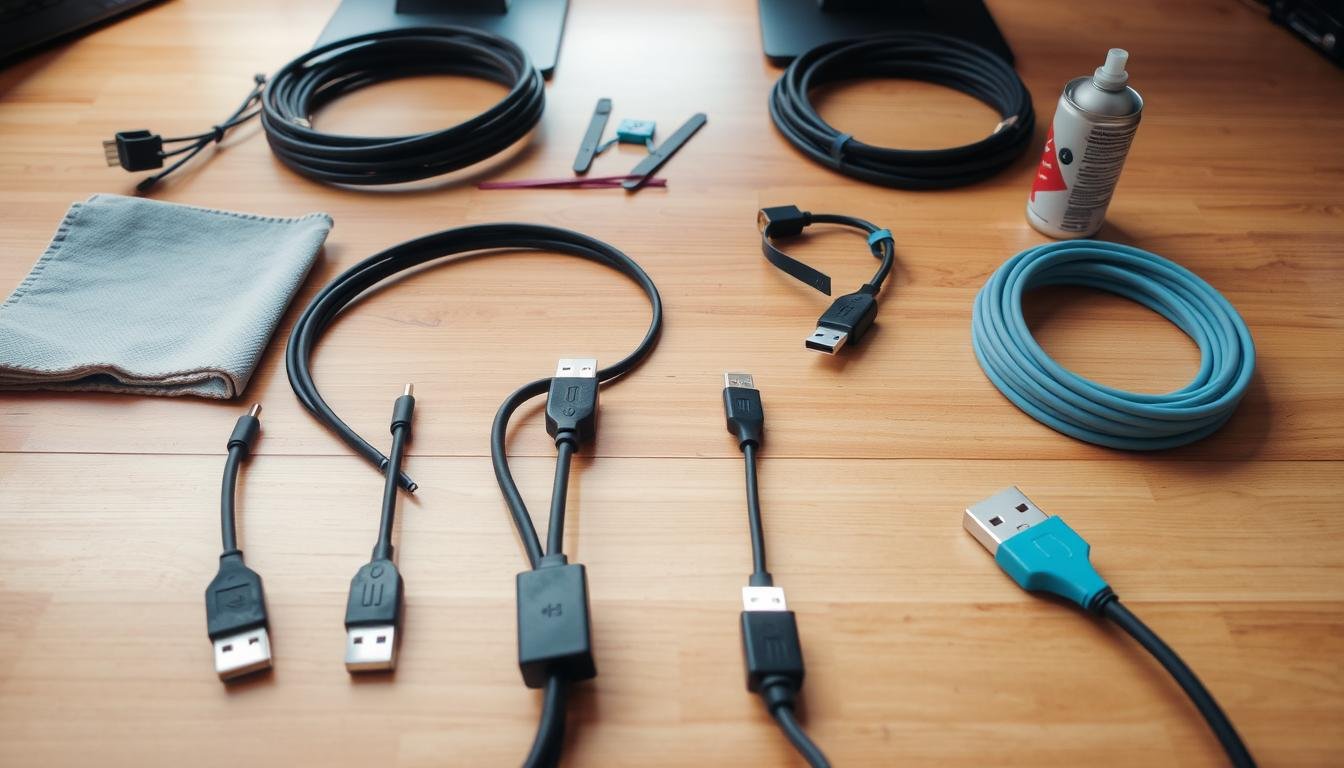USB B cables link many electronic devices. They transfer data and power between computers and other gadgets.
USB B cables are key for connecting devices. They work with printers, scanners, and external storage.
USB B connectors are standard in tech. Their square shape makes them easy to spot.
These cables bridge devices in offices and homes. They support fast data transfer across different platforms.
Let’s explore USB B cables in detail. We’ll learn about their uses and importance.
What is a USB B Cable?
USB B cables connect computers to other devices. Their square connector sets them apart from other USB types.
These cables link printers, hard drives, and scanners to computers. They ensure stable communication between devices in work and home settings.
USB B cables work with many different devices. They support various data transfer speeds, from USB 1.1 to USB 2.0.
Inside, USB B cables have four wires: two for power and two for data transfer.
Many people use USB B cables every day. They help transfer files, charge devices, and connect computer accessories.
Different Types of USB B Connectors
USB B connectors come in several types for specific device connections. The standard USB B is popular for printers, scanners, and external drives.
These connectors have a square shape with bevelled corners. This design makes them easy to spot.
Mini USB B connectors are more miniature for compact devices. They’re found in cameras, MP3 players, and older phones.
These connectors allow for slimmer electronic products. They don’t lose connection quality despite their smaller size.
Micro USB B connectors are even tinier for mobile tech. Smartphones and portable games often use these small connectors.
Their slim profile lets makers design thinner, lighter devices. These connectors still offer good data transfer and charging.
Each USB B type has its use in tech. Knowing these types helps pick the right cable.
You can find the perfect connector for your needs. USB B offers many options for modern device connections.
Key Features of USB B Cables
USB B cables are vital for connecting devices. They offer strong performance for printers and external hard drives.
Transfer rates are a key feature of USB B cables. USB 2.0 B cables deliver up to 480 Mbps.
USB 3.0 B cables can reach speeds of 5 Gbps. These rates ensure quick data movement between devices.
Cable performance depends on conductor quality and signal integrity. High-quality cables have shielded designs to minimize interference.
This shielding protects data transmission during file transfers. It also keeps signal strength consistent.
Power delivery is crucial for USB B cables. Modern cables can support power transmission up to 100 watts.
This allows charging and data syncing at the same time. USB B cables are key for powering various electronic devices.
Durability is essential in USB B cable design. Makers use gold-plated connectors and strong cable jackets.
These choices ensure reliable performance over time. The cables can withstand frequent use and some physical stress.
Comparing USB B with Other USB Types
USB B cables are unique in device connectivity. They connect larger electronics like printers, scanners, and external hard drives.
USB B connectors are square with bevelled top corners. This design prevents wrong connections and ensures proper device hookup.
USB B cables in USB 2.0 support speeds up to 480 Mbps, while newer USB B variants in USB 3.0 can reach up to 5 Gbps.
USB C offers faster data transfer rates. It also supports more power delivery options.
Professionals often choose USB B cables for industrial equipment. These cables provide reliability and robust connections.
USB B connectors are ideal for consistent digital communication. They work well in demanding environments.
Knowing USB differences helps users pick the right cable. This ensures good device compatibility and performance.
How to Choose the Right USB B Cable
Picking the right USB B cable needs careful thought. Device compatibility is the most crucial factor to consider.
Check your device’s specific needs first. Different devices often use various USB B connector types.
Measure the exact length you need. Short cables create tension, while long ones can weaken signals.
Quality brands make a big difference in how well cables work. Belkin, AmazonBasics, and Monoprice offer good USB B cables.
Look for cables with gold-plated connectors and thick insulation. These features improve signal transmission and make cables last longer.
Check what data transfer speed your device needs. USB 2.0 and USB 3.0 cables have different specs.
Some cables can deliver more power. This is important for devices that need a lot of power.
Choose cables with strong points near the connectors. This design helps cables last longer.
Buying a good USB B cable can save you money over time and help you avoid frustration.
Troubleshooting Common USB B Cable Issues
USB B cable problems can be tricky. Let’s look at common issues and how to fix them.
First, check the cable for damage. Look for wear or fraying on the cable.
Next, inspect the connector and port. Remove any dust or debris you find there.
Driver conflicts can cause issues, too. Uninstall and reinstall device drivers on your computer.
Get the latest drivers from the maker’s website. Windows Update can help with this, too.
Try the cable with other devices. This helps find where the problem is.
Use different ports and restart your computer. These steps can help solve the issue.
Check your computer’s power settings. Turn off the USB selective suspend to prevent disconnections.
USB B Cables in Modern Technology
USB B cables are vital for connecting external devices, such as printers and other peripherals in homes and offices.
Printers often connect with computers using USB B cables. Scanners, cameras, and audio interfaces are also used for data transfer.
USB B is a standard for device integration in workstations and home offices. Musical gear and scientific tools also need these sturdy connections.
USB B cables remain important despite newer USB standards. They provide reliable power and data transmission in many tech setups.
People like USB B connections for their simplicity and reliability. These cables connect computers to key equipment in various settings.
Tips for Maintaining Your USB B Cables
Keep your USB B cables in top shape. Good care keeps these vital connectors working well.
Store cables smartly to protect them. Coil them loosely to avoid internal wire stress.
Keep cables cool and dry. Use organizers to prevent tangling and damage.
Check cables often for wear. Look for fraying, exposed wires, or connector damage.
Clean connector ends gently. Use a soft, dry cloth to remove dust.
Handle cables with care. Grip the connector, not the cable, when plugging in.
Unplug cables when not in use. This reduces wear and electrical stress on devices.
A little care goes a long way. Follow these tips for lasting, reliable connections.
Future of USB B Cables
USB B cables are changing with new tech, but they’re still important for special equipment. Printers, medical devices, and audio tools use these reliable connectors.
New connector designs are shaping USB B’s future. They’re getting tougher and faster, and some have better shielding and quicker data transfer.
Engineers are making hybrid connectors, which mix old USB B with new tech. USB B won’t disappear, but it will change.
Some jobs will continue to use USB B. It’s strong and dependable, and research shows that it will stay around.
The slow change lets companies upgrade slowly. They don’t need to replace everything at once. USB B will remain important in many fields.
FAQ
What exactly is a USB B cable?
A USB B cable connects printers and scanners to computers. It has a square-shaped connector with bevelled corners.
How is a USB B cable different from other USB connectors?
USB B connectors have a unique square shape. They’re made for larger devices and offer a secure connection.
What devices typically use USB B connections?
Printers, external hard drives, and scanners often use USB B cables, which are common in offices where sturdy connections are needed.
Are there different types of USB B connectors?
Yes, there are standard, mini, and micro USB B connectors. Each type fits different device sizes and uses.
How do I know which USB B cable I need?
Check your device’s connector or manual. Look at the shape and size of the USB B port.
If unsure, measure the connector or bring it to a store.
What data transfer speeds can USB B cables support?
USB B cables can support speeds from 480 Mbps to 5 Gbps. Check your device and cable specs for the best performance.
How long do USB B cables typically last?
A suitable USB B cable can last 3-5 years. Avoid bending it and protect it from dust and damage.
Can I use an adapter to convert USB B to another connector type?
Yes, adapters can change USB B to other types. Make sure it works with your devices and meets your needs.
you may also read: Exploring R Poe: A Comprehensive Guide to a Rising Trend

